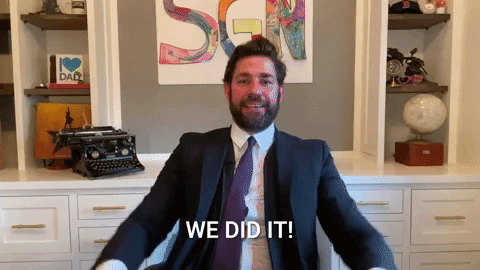End of Course Exam: Short Answer and Long Essay
5 min read•june 18, 2024
Steven Kucklick
AP Seminar 💬
13 resourcesSee Units
Overview of the End of Course Exam
We've made it! The end is finally here.

Image Courtesy of Giphy
And guess what, we've saved the easiest for last 💯!
The End of Course (EoC) Exam is putting to the test a lot of what you've done so far in the year. You'll see elements of the first four Big Ideas in all aspects of the EoC exam ✍️.
Overall, you should feel very comfortable doing what the EoC is asking you to do. It's pretty much a scaled down version of elements of PT 1 and PT 2. Things like analyzing evidence, looking for line of reasoning, and arguing a thesis, all show up in the EoC.
Let's take a look at what you'll actually be doing along with some key points to take note of:
- The exam is divided up into two sections
- Three short answers questions 👌
- One longer argumentative essay 👩🏾💻
- You'll have two hours to complete both sections of the exam
- You can complete the exam in any order that you choose
Before we dive into the nitty gritty, one thing to keep in mind is that the rubrics are short and to the point. This is great because it really highlights everything you need to do without getting too complicated. But, it can be tricky because there are so few points in the rubric so everything counts.
Alright! Let's check out each section.
Short Answer Questions
The first section that you'll see is the Short Answer Questions. Here you'll be given one argumentative article and asked to answer three questions.
The questions are:
- Identify the author's main idea, argument, or thesis. 🤔
- Explain the author’s line of reasoning by identifying the claims used to build the argument and the connections between them. 🗣️
- Evaluate the effectiveness of the evidence the author uses to support the claims made in the argument. 👨💼
These questions can be found in the Course and Exam Description.
You do not need to get super fancy answering these questions. In fact, you should probably be able to answer the first question in just about a sentence. Again, make sure to read the rubrics to really understand how to get full points.
Let's go through each of these questions and talk about them. We'll be using the 2019 EoC Exam as examples as we go through.
Question 1
The first question asks you to identify the author's argument. This should be very simple! You are looking for the overall argument that the author is making.
Usually the author will have a thesis, but if they don't, just ask yourself what overall point the author is trying to make.
Keep in mind that you need to fully explain the author's argument. For example, take a look at Part A of the 2019 exam. The article is titled "Why the Voting Age Should be 17." You might read that and think "Oh! There's the author's argument." But, that is not the author's full argument.
Instead, you should explain why the author thinks 🤔 that. A more complete answer would say: "The author argues that the voting age should be lowered in order to increase voter participation, allow students to be more involved in their government, and strengthen the American democracy."
That answer still says what the title says, but goes in to way more detail.

Image Courtesy of Giphy
Question 2
In question 2, you need to analyze the author's claims and line of reasoning to determine if they support the overall argument the author is making.
Just like with question 1, you may be tempted to give an answer the doesn't fully answer the question. Do not just simply list the author's claims. Instead, you should work through each of the author's claims and explain how they either help or hurt the overall argument 🗣️.
It is better to write too much as opposed to too little here. Really, you should be aiming to write about a page or more.
Question 3
The last question has you looking at the author's evidence. You need to evaluate its effectiveness in supporting the author's claims and analyze the credibility of the evidence.
Just like the claims, you should work through each piece of evidence the author gives, explain how well it supports the argument, and explain how credible it is 🤨.
I would recommend talking about the evidence as a whole. Is it all credible? Does some evidence do a good job of supporting the author's argument while others don't? This will help the question feel a little more organized and focused.
Long Essay Question
The Long Essay Question requires more time and planning than the Short Answer Questions. Generally, I recommend spending an hour and a half on part B.
Even though part B takes longer, what you are doing is fairly straight forward. Essentially, you are constructing an argument using two of four pieces of evidence that College Board provides.
All of the evidence is based around a central theme, but they all have different perspectives.
You are going to select two (minimally) of the four sources and present an argument that is not found in any of the sources. What this means is that if one source argues for 'A' and the other source argues for 'B,' then you need to argue for 'C.' Your argument should NOT 🙅🏽♀️ be the same as one of the pieces of evidence. You may also use the other provided sources or draw upon your own knowledge.
So, how do you write this thing? Here are the steps I would take to write the Long Essay Question.
- Read ALL of the evidence carefully. Find the central theme that is presented. 📕
- Think about what you want to argue that is different than the perspectives presented in the evidence. 👨🏽🏫
- Select the two (or more) pieces of evidence that you are going to use. ✌️
- Write your thesis! ✍️
- Outline your essay, making sure to note your claims and how you connect your evidence to them. 🗒️
- Write, write, write! You should be well prepared to write without stopping to think about the direction your essay is heading in. 📜
- Read and revise if necessary‼️
A few things to note... College Board knows that you are writing on a topic that you might not be well informed on. They also know that you will be using two pieces of evidence and any other knowledge you have. Because of that, this does not need to be the most airtight argumentative essay you've ever written.
That being said, it should have all of the components of a good essay.
In Conclusion...
The best way to prepare for the End of Course exam is to read the rubrics and practice! You can find all the past exams along with sample responses and scoring notes here. Use them to your advantage! Read the responses that scored high grades and recognize why they did well.
But just remember, you have been using these skills all year! You know how to do this. Be confident and don't stress!
Browse Study Guides By Unit
🤨Big Idea 1: Question and Explore
🧐Big Idea 2: Understand and Analyze
👥Big Idea 3: Evaluate Multiple Perspectives
💡Big Idea 4: Synthesize Ideas
🗣Big Idea 5: Team, Transform, and Transmit
✏️Frequently Asked Questions
📚Study Tools
🧐Exam Skills

Fiveable
Resources
© 2025 Fiveable Inc. All rights reserved.